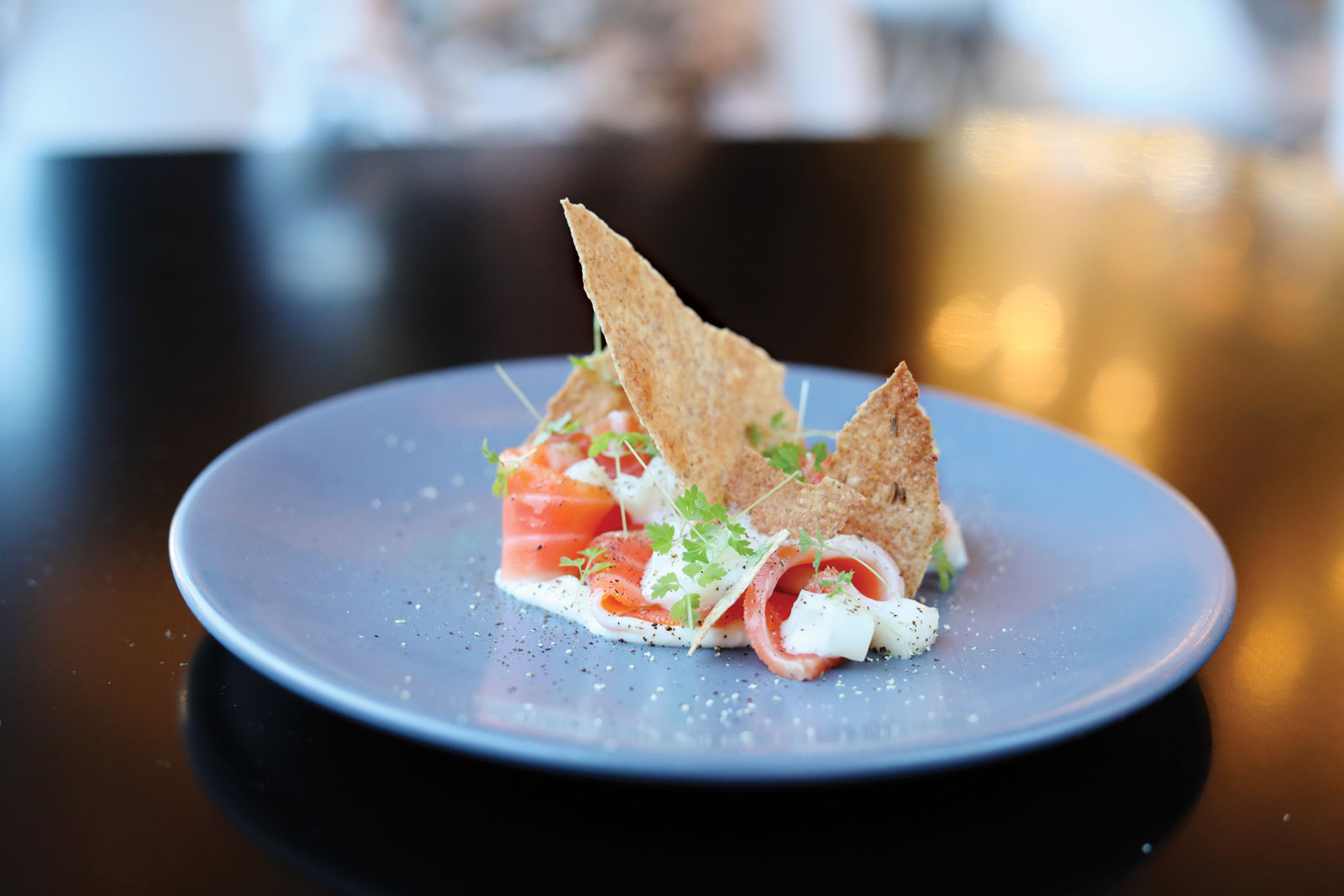The Local newsletter is your free, daily guide to life in Colorado. For locals, by locals.
Emmerson
2.5 Stars
- The Draw:
- Inventive cooking; remarkable desserts; enigmatic cocktails;
a quirky and modern space - The Drawback:
- A few bland dishes; entrées weaker than many small and medium plates
- Don’t Miss:
- Bodega Sando; crudos, tartares, and carpaccio; fusilli and other pastas; desserts
My favorite perch at Emmerson is at the far end of the bar, which affords a view into the kitchen. I like to study the moves of pastry chef Jeb Breakell, a slight fellow with a thin mustache who works at his immaculate station with the focus and economy of an ocular surgeon. When he pulls out a nitrous oxide canister to lay down a yogurt foam blanket in a deep black bowl, it’s for a lovely dish called Shiro Miso Flan. On top of the foam, he creates a brain-coral pattern of Japanese-citrus-infused caramel. Then comes the flan, unctuous and creamy, spiked with bits of poached pear. The foam has a gentle contrapuntal tartness; the caramel is rich with umami. Breakell balances savory and sweet as a poet would.

But wherefrom doth such sweet finesse break? The answer is complicated. Breakell has worked at four New York City restaurants—Blanca, Per Se, Eleven Madison Park, and Atera—with 10 Michelin stars between them. But he is only one part of the puzzle that is Emmerson. The restaurant opened last August in the capacious Lyfe Kitchen corner space on Boulder’s Pearl Street with five partners (four remained at press time), including chef Michael Gibney, also a New Yorker. As if that weren’t firepower enough, the team also recruited Nancy Kwon, a nationally lauded practitioner of cocktail magick, from Los Angeles. Emmerson’s character, virtues, and flaws probably derive from the number of cooks crowding the conceptual kitchen. The place is an amalgam of ambition and quirk. It often succeeds, but it feels like a bold work in progress that could fly to pieces if the partners squabble. I’m not sure the cocktails and desserts come from the same space-time continuum as the rest, but I do like the nerve of the joint.
You get a first taste of the quirk as you enter the anteroom, a cabinet-of-curiosities riff—high shelves filled with taxidermy, leather-bound books, brass bric-a-brac, and examples of ancient technology such as a rotary-dial telephone. Pass through to the modern L-shaped main room, dominated by the long bar displaying more than 90 liquors available by the glass. None of this was done cheaply: The long, gleaming split-plank communal table, draped from above by strings of lights with Casbah flair, is one fancy piece of woodwork.

The limited breakfast and lunch menu is worth sampling if you’re in Boulder between 8 a.m. and 2 p.m. Notable offerings include the $6 Bodega Sando—a paper-wrapped, gooey American cheese, bacon, and egg sandwich in a properly soft roll (a standout New York City–themed touch)—and the soupy, comforting duck leg congee. A few other dishes were not quite fully realized: a lunchtime Reuben whose rye was too thick and too dark and which suffered from an insufficiency of cheese, and a burger that, on two samplings, failed to rise above the ordinary. Daytime eating at Emmerson has a slightly tentative feel. The menu is too concise, the ordering happens at a counter, and the plating can be slapdash.
Dinner, however, is a full-on bustle, beginning with friendly bartenders and moving to attentive service from a legion of staff. If there’s a throughline, it’s the use of Japanese and occasionally Chinese accents to add acid and umami to dishes based on European technique. XO sauce lends savor to Brussels sprouts on a plate of lamb chops and to an aïoli that anchors a tartare of dry-aged lamb. “Arare,” tiny Japanese rice crackers, give crunch to beef carpaccio. Yuzu kosho, a zingy mix of citrus peel, chiles, and salt, complements rib-eye steak.

The affinity for Japanese flavors pops up in desserts and cocktails as well, but this is not fusion fare. Chefs Gibney and Breakell (the latter, though primarily the pastry man, conspires on the savory recipes too) are just as likely to lean on the sharp, winy cut of Banyuls vinegar for a salad, or on funky guanciale for a carbonara, or on sea urchin and blue cheese to enliven sweet potato gnocchi (sounds odd, tastes good). At dinner, details matter: The pecorino crisps with the baby Tuscan gem salad are the thinnest, most intense I’ve tasted. The house-cultured butter with the crackle-crusted pain d’epis elevated the bread to a course in its own right.
Some preparations are brilliantly simple. Exhibit A: toasted wheat fusilli with braised short ribs, mild Castelvetrano olives, and anchovy breadcrumbs. Try it with something interesting, like a bottle of Occhipinti Il Frappato 2015—a juicy, tart Sicilian wine made entirely from Frappato grapes—from Emmerson’s well-curated (if pricey) wine list. Other pastas, such as the ribbonlike mafaldine with lamb and duck Bolognese, were also spot-on.
These rustic plates contrast with the Gibney/Breakell penchant for uptown cooking. Certain dishes—particularly the raw offerings—might have been flown in from Michelin-starred joints, so precise are they in flavor, texture, and plating. Atlantic black bass crudo, for example, is a wee appetizer served in a bowl that looks to be made from undulating obsidian. Inside, the fish rests on a silky purée the menu calls an “oceanic emulsion,” which marries perfectly with the raw bass. Even better is the beef-rib carpaccio: luscious slices of meat topped by two raw oysters, translucent dimes of radish, and a cream made from Brie.
All of the above come from the plus side of the ledger. On the minus side, I noted a surprising blandness in several dishes and some flat-out kitchen errors. Honey-roasted duck breast came with whole-grain porridge (chewy and good) and a heap of vegetable curlicues, but the plate wandered aimlessly in search of compelling flavors and the duck was flabby. Lamb chops with “merguez spice and shrimpy grits” promised big flavor action but tasted like Michael Bolton’s jazz sounds. Twice I ordered a starter of charred cucumber with grapes, pepita crumble, and pumpkin-seed yogurt, intrigued by the idea of cucumber char, but none was present.
I puzzled over and enjoyed half of the cocktails from Nancy Kwon’s first program (she’s promised an update in the new year), which seemed to have been teleported from a hardcore rock speakeasy in a land where half-naked Amazonian women slay cloven-hoofed foes and then celebrate with elixirs of magical power. Each of her drinks, or “Emmerson Bar Experiences,” has a name like Elysium or Ixchel and is supported by a Heavy Metal magazine–style booklet of fantasy illustrations.
Kwon is unquestionably a master alchemist, tinkering with bitters, amari, jungle fruits, off-piste liqueurs, and oddities such as soursop nectar and yerba mate tincture. Her drinks are bracing, frequently sharp, and mysterious. I especially liked the ka-pow intensity of the overproof rum- and shrub-forward Guildive and the zingy Hi-Teq, made with hibiscus liqueur, tequila, lime, and verdant rhum agricole.
We began with dessert, so let’s finish with one: Breakell’s masterful pavlova. A low meringue dome encases thick, salty buckwheat cream. Whack the thing with a spoon, then make sure to scoop up bits of the sweet meringue and gobs of the cream. Flavors of malt and grass abound. I’ve never had a dessert that skirts so close to savory without losing the sweet plot. It’s a dish worth dining out for—the sort that leaves me optimistic the complicated enterprise that is Emmerson may grow into one of Boulder’s finest restaurants.









